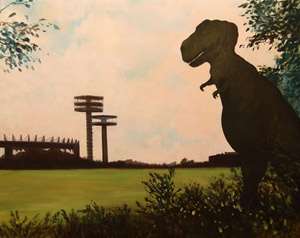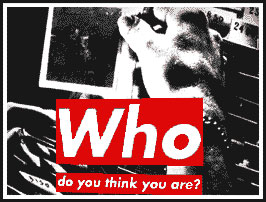Will They Ever Return?
John Haberin New York City
Art After Covid-19
They take daring and cash up front to open, and they survive from month to month or even day to day. They may draw a party crowd now and then, with all its risks to public health, but they matter just as much as a quiet place to catch up with yourself and maybe something beyond yourself.
They are part of the fabric of the city, and for now they are gone. Will they ever return, and what will happen to the people who worked there or to you? I could be talking about a favorite local bar here in New York. And the impact of shuttered bars, restaurants, and pretty much the entire hospitality sector could be devastating—for individuals and the economy.  If you are reading this, though, your first thoughts will go out to galleries, as do mine. You may be thinking as much of your everyday habits as of the power of arts or a public crisis to expand minds.
If you are reading this, though, your first thoughts will go out to galleries, as do mine. You may be thinking as much of your everyday habits as of the power of arts or a public crisis to expand minds.
Are you wrong to worry about them when people are dying and the economy is shutting down? A look at the hard realities of art, money, and Covid-19 makes one thing clear: it is not just a matter of esthetics and a preference for art over life. Still worried where to go in the interim, other than online? Worried for a poor critic on lockdown like me? The real question is what will come next,
Short of breath
I need hardly tell you that many have already closed in just the last few years, even as others survive. And some thrive, particularly at the high end, where (to quote Bob Dylan) money doesn't talk; it swears. I am still getting over this past fall's new seven-story building for Pace gallery—just as an entire neighborhood of galleries in Brooklyn, Bushwick, all but bites the dust. Gambles like nonprofits and collectives have a cushion, too, in the artists they serve. That still leaves the edgier midlevel galleries that discover and promote rising artists. As this site has often reflected, art's future turns on them, and spring art fairs ignore them at their peril.
Their vulnerability stood out in the aftermath of another disaster, Hurricane Sandy in 2012. Then, though, the damage was immediate and physical. Here the scope is greater and much harder to predict. For now, I may miss more the public privacy of a workout or the human contact over a beer, but bars will always be with us, even after Covid-19. So, I suppose, will artists—and, not for the first time, memories of disaster will inspire art. But will they still have a place to exhibit, and what happens when the answer is no?
Some argue for dealers without galleries or, at best, "virtual exhibitions"—a so-called hybrid model of fairs, online art fairs, pop-ups, and appointment only. Yet there again only high-end dealers can consistently afford the model, while the low-end can safely ignore it, leaving what matters most at stake. A linchpin of that model, the art fairs, in fact puts far greater financial pressure on galleries with a small staff and a modest budget. The pressure is obvious once again so soon after the March fairs with a major announcement: the Armory Show will move closer to Chelsea galleries while stretching out fair season to September. That puts the tension between its benefits and its cost in full view.
Museums feel the pain, too—in the case of the Met, a projected deficit of well over $100 million with museum reopenings difficult to foresee (while the American Folk Art Museum remains shut even now, and a much smaller deficit has the Brooklyn Museum planning to deaccession major works). Unlike galleries, they may face budget constraints rather than outright closings, and the Frick Collectin is expanding while adopting temporary home in the Frick Madison. Yet they draw tourists and employ an awful lot of people. Firings at the Met in 2016 made that all too clear. Are more on their way? The Met planned to reopen in July and then late August with a reduced program to rein in costs, but the date keeps slipping further and further into fall.
Museum expansions, in turn, raise costs, so that cutbacks could even have a perverse benefit in compelling them to focus on their mission and their art. Holland Cotter in The New York Times pleads for more modest and diverse museum displays—and yet modesty and diversity may still get in each other's way. That is why a monster project like MoMA's 2019 expansion is, so far, paying off. Museums and galleries can also use the present occasion to boast of online exhibitions, including a splendid "virtual walk" through nineteenth-century Rome at the Morgan Library, but is that even novel? They ask you to believe that they never before had Web sites or digitized their collections. They also ask you to forget that art has the virtue at times of freeing you from the computer screen.
In good times, the arts and the economy feed one another, but now that, too, is in danger. Cultural institutions bring money to cities, while cutbacks feed a recession, and a recession will be devastating for the arts. In the short term, galleries lose sales from closures, while museums lose admission fees. They will have to face a shortage of cash and collectors for a lot longer—and the Frieze art fair has already called it quits for this May. Government at all levels has begun to help, by limiting the spread of the virus and by bolstering businesses and individuals that have lost their livelihood. Still, one symptom of the virus is difficulty breathing, and I am not holding my breath.
I Am Still Here
These are terrible times—between rising unemployment and rising deaths, police brutality and racism, anxiety and anger. But could they also be a time for reflection? Yes, that is yet another platitude, like so much advice these days, but what else is there to do? So here is mine, but first a boast. This site has kept you and others abreast of art for over twenty-five years, and it has continued to do so despite a lockdown and a curfew. After more than three months, I still cannot see art, but I cannot help thinking about it, and I cannot stop asking why.
As I have argued more than once, art criticism can be about more than loaded adjectives and picking winners. Did you know that most publications ask you to pitch reviews before shows open, based on name alone and not on what you as a writer can contribute? I started this site to afford a little more time and space. I wanted it to be equally at home in contemporary art and art history, because art's vitality turns on the joys and battles of both past and present. I wanted to be able to draw on scholarship, theory, philosophy of art, the power of words, and the very need for interpretation if you are to make unfamiliar art your own while staying accessible and, now and again, entertaining. The present crisis has put all that to the test.
 I do not mean to offer comfy advice like many a purported expert, when I myself am near despair. Use your time off for something creative that you have put off way too long? That is what I cannot do with galleries and museums closed and shows canceled or postponed—even summer sculpture outdoors. Finally, clean out your closets? I am anal enough, thank you. Still, I have maintained (so far) my schedule of three posts each week, first thing Monday, Wednesday, and Friday.
I do not mean to offer comfy advice like many a purported expert, when I myself am near despair. Use your time off for something creative that you have put off way too long? That is what I cannot do with galleries and museums closed and shows canceled or postponed—even summer sculpture outdoors. Finally, clean out your closets? I am anal enough, thank you. Still, I have maintained (so far) my schedule of three posts each week, first thing Monday, Wednesday, and Friday.
Many excerpt more in-depth reviews in my archive now of thousands—and all link to a page for museums, galleries, and other art resources, listing (normal) hours and their URLs for more. Yes, I have used these many long weeks to weigh in on Covid New York, art after Covid-19, "virtual exhibitions," and now online art fairs, with doubts and fears about all. Still, I have held off on weekly picks of exhibition Web sites, because that, too, would be a poor excuse for picking winners. You will just have to decide for yourself what do this weekend. So how have I kept the pace? And then my boasting has to give way to reflection and a confession.
In another sense, I have failed to keep pace with exhibitions. I have sat on reviews for weeks, while writing more than I need for my blog. That allows for rethinking and rewriting, for your benefit and mine, and it allows me to stay abreast of art. Still, in practice it means that I am often late sharing them with you. I try at least to post a review before an exhibition closes, but even that may feel too late to you, and now and again I fail. The blog, I can always say, is only a teaser to longer articles, and I replaced my home page with it in the first place only after the first eight years of building that archive.
I have no idea where that leaves me, other than yet another budding but aging writer on the margins. I may run out of posts all too soon, and I may never manage to resume the same hectic pace. Still, for one last shot at optimism, the down time presents yet another opportunity. On my home page, as opposed to here, I used the next two weeks for reviews earlier this year that somehow fell through the cracks and never made the blog. Maybe I was pitching them to other outlets, allowing rights of prior publication—and maybe they took me up on it, or maybe they did not. See for yourself what they were missing.

Almost all New York museums and galleries shut their doors on March 19, 2020, but they had already all but emptied. City and state government insisted on it a few days later. Related reviews consider Covid New York, museums after Covid-19, galleries after Covid-19, and claims to have moved shuttered galleries, museums, and fairs online, as Frieze online and "virtual exhibitions."




